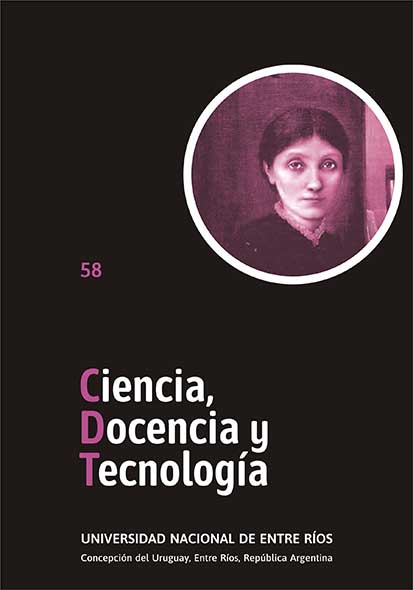Abstract
This article is part of the studies that analyze the transition of scientific production to a paradigm that includes a better applicability and socioeconomic relevance of science. Based on the analysis of the professional trajectories of two scientific researchers, we use the concept of «boundary work» (Gieryn, 1983) to explore how technological development shape their professional identity. In particular, boundary work analysis make explicit different ways of experimenting and making sense of the changes that challenge the two professional trajectories. This led us to identify two modalities of conversion from scientist to scientist-technologist: one that emphasizes institutional opportunities and professional strategies; the other that highlights personal commitment to give a social and political meaning to the conversion.
References
ALBORNOZ, M.; Ariel GORDON, A. (2011). La política de ciencia y tecnología en Argentina desde la recuperación de la democracia (1983–2009). (pp.1–46.) En: ALBORNOZ, M.; SEBASTIAN, J. (comp.). Trayectorias de las políticas científicas y universitarias de Argentina y España Madrid: CSIC.
AMSTERDAMSKA, O. (2005). Demarcating Epidemiology, en: Science, Technology, & Human Values, 30(1):17–51.
ASHMORE, M.; BROWN, S. D.; MACMILLAN, K. (2005). Lost in the Mall with Mesmer and Wundt: Demarcations and Demonstrations in the Psychologies, en: Science, Technology, & Human Values, 30(1):76–110.
BURRI, R. V. (2008). Doing Distinctions. Boundary Work and Symbolic Capital in Radiology, en: Social Studies of Science, 38(1):35-62.
CALVERT, J. (2006). What’s special about basic research?, en: Science, Technology & Human Values, 31(2):199-220.
CAROZZI, M. J.; FRIGERIO, A. (1994). Los estudios de la conversión a nuevos movimientos religiosos: perspectivas, métodos y hallazgos (17-53). En: FRIGERIO, A.; CAROZZI, M.J. (ed.) El Estudio Científico de la Religión a Fines del Siglo XX. CEAL, Buenos Aires.
CLARK, B. R. (1998). Creating Entrepreneurial Universities. Oxford: Pergamon Press.
DELVENNE, P.; THOREAU, F. (2012). Beyond the ‘‘Charmed Circle’’ of OECD: New Directions for Studies of National Innovation Systems, en: Minerva, 50:205–219.
ETZKOWITZ, H.; LEYDESDORFF, L. (2000). The dynamics of innovation: from National Systems and “Mode 2” to a Triple Helix of university–industry–government relations, en: Research Policy, 29(2):109–123.
ETZKOWITZ, H.; WEBSTER, A.; GEBHARDT, C.; Terra, B. (2000). The Future of University and the University of the Future: Evolution of Ivory Tower to Entrepreneurial Paradigm, en: Research Policy, 29(2):313–30.
FRIEDBERG, E. (1997). Le pouvoir et la règle. Dynamiques de l’action organisée. Paris: Editions du Seuil (deuxième édition).
GIERYN, T. (1983). Boundary-Work and the Demarcation of Science from Non-Science: Strains and Interests in Professional Ideologies of Scientists, en: American Sociological Review, 48(6):781-795.
GIERYN, T. F. (1999). Cultural boundaries of science: credibility on the line. Chicago: University of Chicago Press.
HERRERA, A. O. (1973). Los determinantes sociales de la política científica en América Latina: Política Científica Explicita y Política Científica Implícita, en: Desarrollo Económico, 13(49):113-134.
HUBERT, M.; CHATEAURAYNAUD, F. ; FOURNIAU, J.-M. (2012). Les chercheurs et la programmation de la recherche : du discours stratégique à la construction de sens, en: Quaderni, 77: 85-96. Disponible en: < http://quaderni.revues.org/556 > [23 de abril de 2018].
HURTADO, D. (2010). La ciencia argentina. Un proyecto inacabado: 1930-2000. Buenos Aires: Ed. Edhasa.
INTROVIGNE, M. (2010). El hecho de la conversión religiosa, en Scripta Theologica, 42: 359-383.
INVERNIZZI, N.; HUBERT, M.; VINCK, D. (2014). Nanoscience and Nanotechnology: How an Emerging Area on the Scientific Agenda of the Core Countries Has Been Adopted and Transformed in Latin America. (pp.223-242.) En: MEDINA, E.; DA COSTA MARQUES, I. ; HOLMES, C. (ed.) Beyond Imported Magic. Essays on Science, Technology, and Society in Latin America, MIT Press, Cambridge, Massachusetts.
LAM, A. (2010). From ‘Ivory Tower Traditionalists’ to ‘Entrepreneurial Scientists’? Academic Scientists in Fuzzy University – Industry Boundaries, en: Social Studies of Science, 40(2):307-340.
LOUVEL S.; HUBERT, M. (2016). The Use of Foreign Examples in Research Policy. Public Funding for Nanoscience and Nanotechnology in France, en: Revue Française de Sociologie (English Supplement), 58(3):473-501. Disponible en: < https://www.cairn-int.info/journal-revue-francaise-de-sociologie-2016-3.htm > [23 de abril de 2018].
LOVBRAND, E. (2007). Pure Science or Policy Involvement? Ambiguous Boundary-work for Swedish Carbon Cycle Science, en: Environmental Science & Policy, 10(1):39–47.
LUNDVALL, B. Å. (ed.) (2010). National Systems of Innovation: Toward a Theory of Innovation and Interactive Learning. London: Anthem Press.
NOWOTNY, H.; SCOTT, P.; GIBBONS, M. (2001). Re-thinking science. Cambridge: Polity Press.
RIP, A. (2002). Regional innovation systems and the advent of strategic science, en: The journal of technology transfer, 27(1):123-131.
SPIVAK L’HOSTE, A.; HUBERT, M. (2012). Movilidad científica y reflexividad. De cómo los desplazamientos de los investigadores modelan modos de producir conocimientos, en: REDES – Revista de estudios sociales de la ciencia, 18(34):85-111.
TUUNANINEN, J. (2005). Contesting an hybrid firm at a traditional university, en: Social Studies of Science, 35(2):173-210.
ULNICANE, I. (2015). Broadening Aims and Building Support in Science, Technology and Innovation Policy: The Case of the European Research Area, en: Journal of Contemporary European Research, 11(1):32-49.
The authors retain the copyright and grant the journal the right to be the first publication of the work, as well as licensing it under a Creative Commons Attribution License that allows others to share the work with an acknowledgment of the authorship of the work and publication initial in this magazine. All content is published under the Creative Commons 4.0 international license: Attribution-Non-Commercial-Share Alike.

